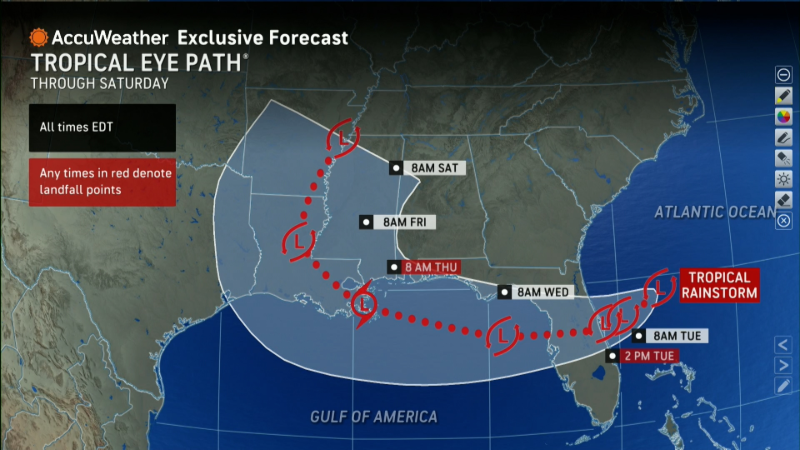75 million Americans under heat advisories; New Orleans braces for deluge

Almost 75 million Americans in the East and South were under heat advisories July 17 as intense summer weather gripped much of the nation, the National Weather Service said.
New York City was under a heat advisory for a second straight day, and residents were urged to call 311 for help finding cooling centers and obtaining "Beat the Heat" safety tips.
The National Weather Service warned that seniors and those with chronic health problems or mental health conditions faced increased risk. As the planet warms, heat-related deaths are increasing in the U.S., according to a study published last year in the American Medical Association journal JAMA. The study, which reviewed federally reported data since 1999, said more than 2,000 heat-related deaths have been reported annually in recent years.
"We're not done with this heat just yet!" New York Mayor Eric Adams said in a social media post. "Be sure to hydrate, use one of our cooling centers, and check on your pets and vulnerable neighbors. Together, we can all Beat the Heat!"
Storm could dump almost a foot of rain in Louisiana
A dangerous weather system hovering over the northern Gulf probably won't develop into a tropical depression but could still produce flash flooding in the region, the National Hurricane Center said in a forecast issued July 17.
Forecasters had earlier warned the system could grow more powerful as it approached the Louisiana coast, and New Orleans could soon be in the storm's crosshairs. Mayor LaToya Cantrell ordered city buildings closed to the public on July 17, 2025, although city services will remain available virtually.
However, the most recent wind data and surface and rader observations indicate the swath of low pressure "remains quite disorganized," senior hurricane specialist Philippe Papin wrote.
"While some additional development of this system remains possible over the next 12-24 hours, its current structure suggests its chances of developing into a tropical depression before it reaches the Louisiana coast later today are decreasing," Papin wrote.
Child killed in lightning strike at NJ archery range
One person was killed and 14 injured − including children − in a lightning strike at a New Jersey archery range July 16, authorities in Jackson said. The lightning strike killed a 61-year-old instructor, city officials said.
“Eight of the victims were juveniles,” Jackson Mayor Michael Reina said. “It looks like the victims were with (Scouting America) or Cub Scouts. Unfortunately, every single one of the 14 were taken to hospital.”
The strike at Black Knight Bowbenders range occurred in the evening, shortly before a severe thunderstorm warning was issued for the area, according to Joseph Candido, Jackson public safety information director. The club was hosting a competition for the scouts, Candido said.
− Erik Larsen and Lisa Robyn Kruse, Asbury Park Press
Louisiana residents fill sandbags, prepare for flooding
In St. Charles Parish, 20 miles west of New Orleans, parish President Matthew Jewell said emergency preparedness personnel were closely monitoring the storm. He warned residents that 3-5 inches of rain could be expected by July 19, and there is the potential for up to 10 inches in some areas. Sand for sand bags was being provided at multiple locations; residents were told to bring their own shovels and proof of residency.
Amanda Babbin, one of the first in line, has seen flooding before at her parish home.
“Two weeks ago, that heavy rain, my backyard flooded," Babbin told wwltv.com. "The water started coming into the back half of my house, my garage and all."
Katrina survivor taking no chances
In Plaquemines Parish, 60 miles south of New Orleans, Joanne McClelland was stocking up on essentials at the Breaux Mart. McClelland, who said she was also shopping for her mother in her 90s, told wdsu.com she has lived through numerous storms including Hurricane Katrina. That Category 5 storm slammed onto shore in 2005 on a path of destruction that killed more than 1,300 people and was blamed for damage in excess of $100 billion.
"Hopefully it won't be too bad," McClelland said of this week's storms. "But once it goes into the Gulf, warm waters, you can't take chances."
How much rain could fall in New Orleans?
Papin also said the storm would bring heavy rainfall to the region regardless of how well it organizes, and a flood watch was in effect for the region through Friday night.
The National Weather Service in New Orleans said several rounds of heavy rainfall were forecast through at least Friday night. Up to 2 inches and some isolated higher amounts had already fallen early on July 17, and an additional 2 to 4 inches was forecast. Locally higher amounts up to 8 inches were possible. Rainfall rates in excess of 2 to 4 inches per hour are likely with some storms.
What is a tropical depression?
Some clusters of thunderstorms over warm ocean waters develop well-defined centers and thus become tropical cyclones. A tropical depression is a tropical cylcone with maximum sustained surface winds averaging less than 39 mph.
A tropical depression becomes a named tropical storm when sustained wind speeds reach 39 mph. When winds reach 74 mph, the storm officially becomes a hurricane.